I’m willing to bet you came across this article because you were looking for the latest and greatest tactics to be found in the world of SEO. No shame in that. We all want to keep up with the algorithms and maybe even get out ahead of them a bit. But as you read your daily dose of web marketing posts, looking for some new strategies you can use, tread carefully. Many of the “killer” SEO strategies you’ll read about today will be the very same strategies that will get you killed by algorithm penalties tomorrow.
As web marketers, it’s important to stay ahead of the algorithms. But in order to do that, sometimes you have to take a look back at what once worked but doesn’t any longer. You’ve heard it said those who don’t learn from history are doomed to repeat it.
If you don’t want the past to haunt your web presence, take a lesson from these five killer SEO tactics from yesterday that will get you killed today.
1) Keyword-Focused Pages
Why it Killed Yesterday
One of the primary roles of SEO from the beginning has been to optimize content to rank for keywords. In the past, many SEOs told you to target only one keyword (or phrase) per page in order to keep it focused. I never subscribed to this strategy, but I did understand the concept of having a narrowly focused page on a particular topic.
While keyword density has been a dead SEO tactic for years now, keywords on the page still mattered. And the more “focused” you kept each optimized page, the better chance you had at ranking for the key phrase you are targeting.
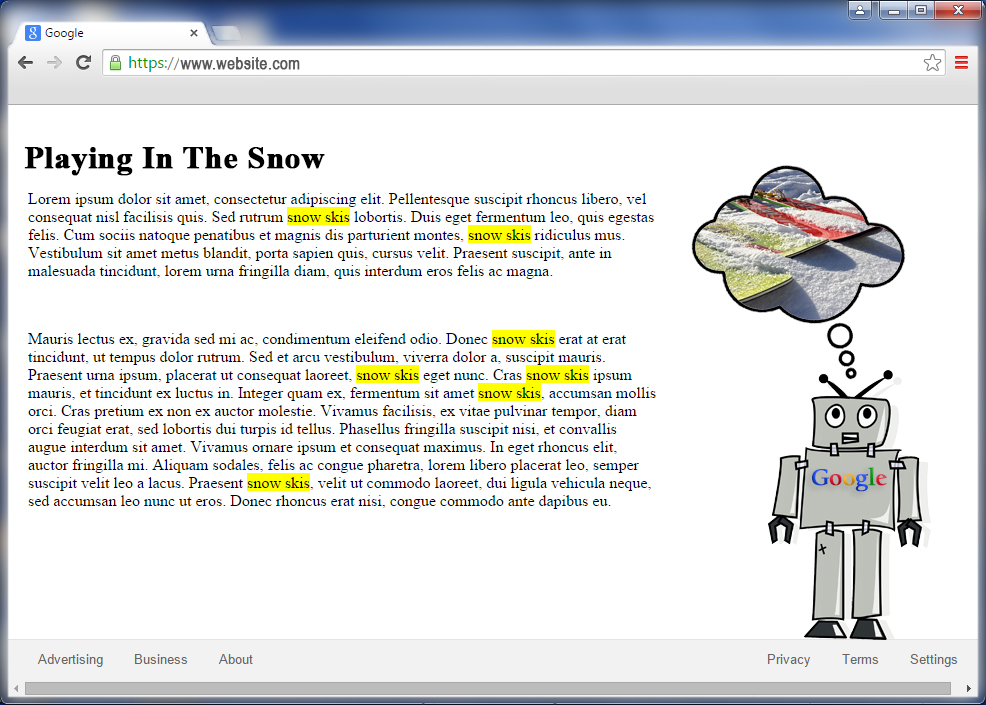
Why it Will Get You Killed Today
With the Hummingbird update, Google has basically rethought how they want to analyze pages and implemented some new technology to do it. Instead of focusing on the keywords themselves, the search engines are now looking at the ideas represented by the keywords. In other words, it’s not the keywords that the page is ranking for but the topic.
When you optimize content for keywords, you’re being shortsighted. Remember, Google has access to billions and billions of pages of content. And they have the computing power to analyze that content in order to understand what makes one page better than another. If you want to rank for “snow skis,” but your content fails to say much about things that skiers find important (other than they type of ski they use), you’re going to miss the mark. By a long shot.
Google knows what’s important to skiers because they’ve analyzed thousands of pages of content written by those very skiers. They know the language, the lingo, the style and, ultimately, what skiers want to know about their skis, ski slopes and performance in a variety of snow types. Just repeating the word “snow skis” over and over again just won’t cut it.
How to Kill it for Tomorrow and Forever
Does all this mean that we no longer optimize pages for keywords? No. But now it’s less about the keywords and more about optimizing the content for the topic. So if you’re selling snow skis, you need to talk about different ski types, the terrain for the skis, ski flex, width, etc.
Yes, you’ll use the term “snow” and “skis” on the page and probably more than a couple of times, but you’re not focusing on those words. Instead, you’re focusing on the function, perception and value of the skis in relation to the skier.
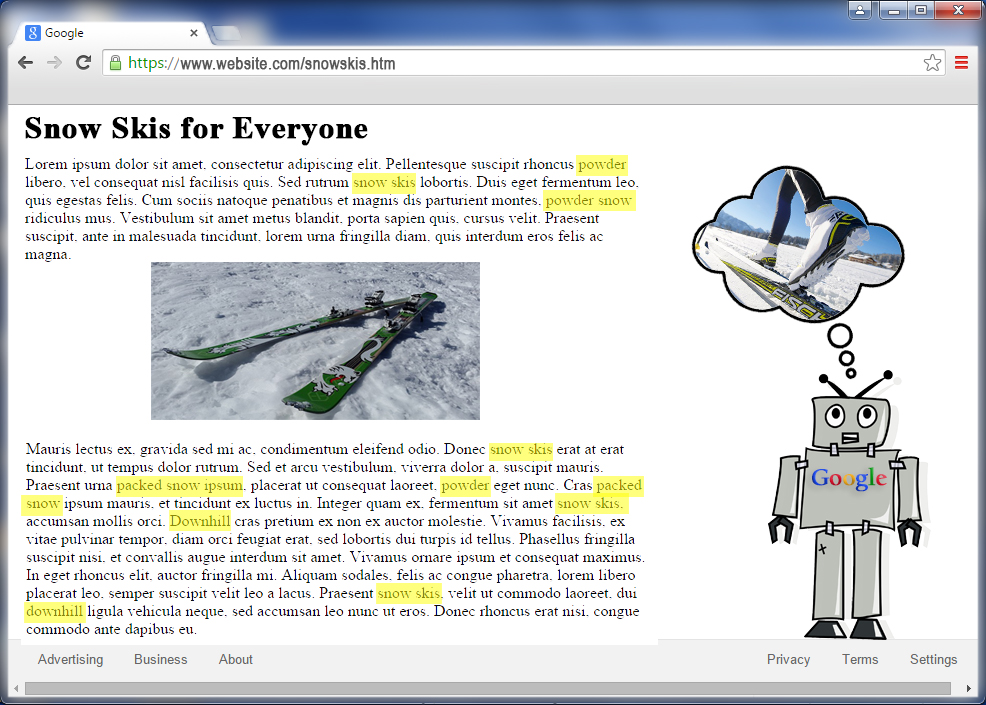
Keep in mind that in order to rank for your given keyword, you don’t have to write the be-all, end-all authoritative piece on snow skies. In fact, that may not work well for the audience you’re trying to reach. Not everyone is ready for Every Skiers Guide to Skis, Terrain, and Downhill Performance. Determine what message you need to get your visitors to take the next action, and then write the most authoritative piece you can with that focus.
Focus on the topic in relation to the visitor’s need. You can literally write dozens of authoritative pages on a single topic, all with a slightly different focus. Each of those pages will rank for different sets of keywords, which should tie directly into what type of content a particular searcher is looking for.
2) Link Buying
Why it Killed Yesterday
Before Google, search engines relied primarily on on-page optimization to determine how a page should rank. When Google came around, they changed all of that by adding links as a core part of their algorithm.
It made sense. If we all used on-page factors, then getting a top ranking was just a matter of adding your keywords slightly better than the next guy. Unfortunately, this led people to optimize pages for things that were not necessarily relevant in order to draw in the traffic. Google realized they can’t rely just on what someone says is on the page but by what other people say about that page.
Enter links. Every link to a page is, essentially, a vote for the page. The more votes a page has the better it should rank.
Enter SEOs. Knowing that these votes can dramatically alter the search engine rankings, SEOs started buying links en mass to increase rankings. It wasn’t out of the ordinary to hear SEOs say “I just bought $10,000 worth of links for my client.” And as long as buying those links helped improve rankings, that $10,000 investment could translate into $100,000 in new revenue.
Why it Will Get You Killed Today
In 2012, Google rolled out the Penguin algorithm designed to target manipulative link building practices. While links remain an important part of the search engine algorithms, paying for links as a way to manipulate the algorithm is severely penalized.
Wary of unnatural link-building practices, the search engines are looking for links that are truly earned. Essentially, link buying is out. But do the search engines really know if you bought a link or not? They can’t be certain, but there are a number of tell-tale signals. Trigger enough of these, and you’ll be in the hurt.
How to Kill it for Tomorrow and Forever
If you do buy links, do it only for advertising purposes. As such, be sure to use a nofollow tag on each and every purchased link. This will allow you to get the traffic without being seen as manipulating the algorithm.
You can still engage in natural link-building practices. But that means no quid pro quo. Feel free to contact other site owners, pointing out something of value on your site and ask if they will link to it. They might.
As important as links are, social media has, essentially, taken their place. Not in terms of algorithmic importance but in terms of the best way to build natural links. Engaging online with your followers, pushing out great content and commenting on other’s content will build relationships that will often turn into links without even asking.
3) Anchor Text Optimization
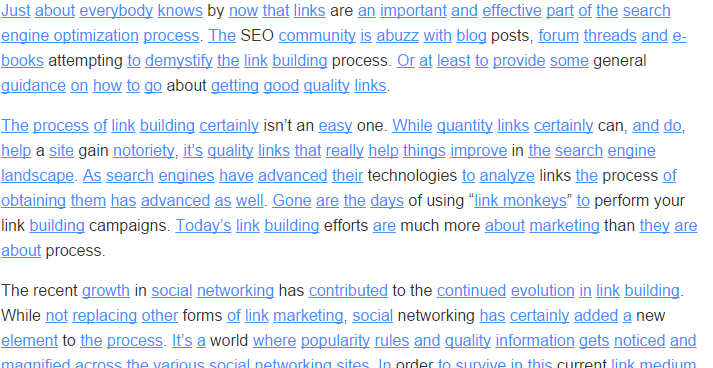
Why it Killed Yesterday
Almost since links became part of search engine algorithms, anchor text has been used as a signal of the relevance of the page being linked to. If you are pointing someone to content about car batteries, it makes perfect sense to include the words “car batteries” in the link text. We do this all the time with navigation because, well, at the risk of repeating myself, it makes perfect sense. You don’t have a navigation link that reads “batteries” that goes to light bulbs!
In fact, search engines will use anchor text in a link to get an initial idea as to what a page is about without ever having to visit that page. That link text can be the very first signal the search engines get about a page. It’s no surprise then that SEOs optimize link text with keywords to promote the relevance of pages to the search engines.
Why it Will Get You Killed Today
As part of that “optimization,” SEOs would often go out and secure large numbers of links for the target keyword, all pointing to the same page. The results would be a pretty abnormal link signature. After all, how many people are likely to link to the exact same page of a site using the exact same anchor text?
Maybe a few, but a few algorithm tweaks allowed search engines to sniff out manipulation. Whether you’re paying for links or getting them for free, having your site get hundreds of similar links just raises too many red flags, even if you do spread them out over time.
How to Kill it for Tomorrow and Forever
Does that mean you should never use keywords in anchor text? Not at all. It’s still a signal. Search engines are just looking for excessive manipulation of link anchor text. One way to avoid setting off the penalty alarms is to not get a surge of new links without new content to back it up. If you just produced a new piece of content that gets shared over social media, search engines can see that those links were likely earned. However, one hundred new links to a page that’s been around forever will likely look suspicious.
Another way is to make sure any new links you secure do not use the exact same anchor text. As much as you may have control over this, have your link text incorporate more of the sentence around your keywords than just the keywords themselves.
On your own site, continue to use your keywords within navigation and breadcrumbs. This will always make sense. In your body content, if you see an opportunity to link to another page, take it. Feel free to include the keyword within the linked portion of the text, but follow the same guidelines as in the paragraph above.
4) Link Sculpting
Why it Killed Yesterday
Years ago, the search engines got together and created the “nofollow” tag. Designed initially as a way to discourage blog comment spammers, the tag quickly turned into a requirement to mark paid links. It was a way for us to notify the search engines which links should not pass any link value to the linking page due to it not being a free, organic link.
It didn’t take long for SEOs jump on that as a way to “sculpt” how link flow should be passed through the site. Essentially, SEOs believe that if you had ten outgoing links on a page, and you nofollowed all but one of them, the “dofollow” page would receive 100% of the outgoing link value.
Got a page that you don’t want “stealing” link value from other pages? No problem, just add a nofollow tag to all the links and it’s just as if that link wasn’t there! If Page A has three links to Page B, you would nofollow two of those links so only the value of one of those links was lost.
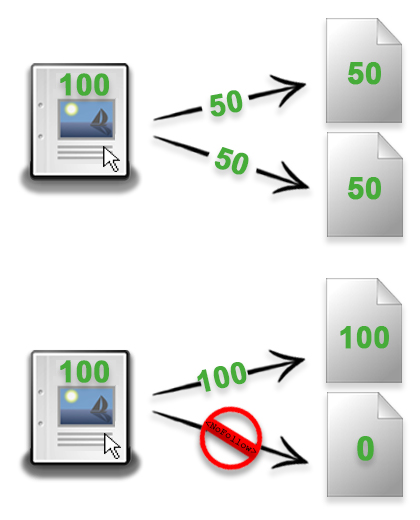
Why it Will Get You Killed Today
The problem with link sculpting is it never really worked. According to Google, a nofollowed link doesn’t prevent the link value from flowing out of the page, it just prevents it from flowing into the linked page. The link value is still lost.
If you have the same ten links, all but one nofollowed, the dofollow link passes only one-tenth of total value available. The other nine-tenths is lost. Gone. Kaput.
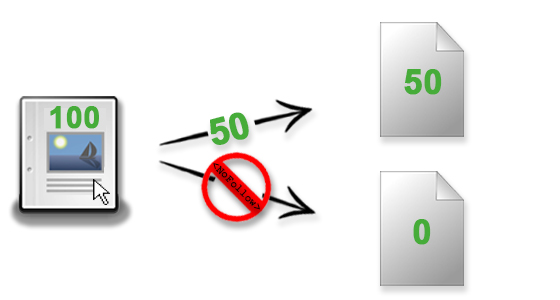
Nofollow tags should not be used for internal site links. They should only be used for external links to other sites that you don’t want to pass link value to (or are paid ad links). When you fill your own site with nofollow links to your own pages, you’re just hurting yourself. You’re not hoarding page value, you’re causing it to disintegrate into thin air.
How to Kill it for Tomorrow and (maybe) Forever
So link sculpting doesn’t work, and we don’t want to lose page value by adding links that don’t pass it on. The problem is, sometimes there are hyperlinks that have to be added to your site that are designed to perform a function rather than going to other site pages. Those links, essentially, are causing you to lose page value.
The solution, then, is to eliminate the hyperlink from those functions. Just as if someone was using their mouse to click on a tool, those clicks don’t count as hyperlinks. Similarly, if someone wants to logout, view cart, socialize a post, write a review, sort, filter, compare, email page, etc., those functions also shouldn’t count as a link to a page. But as long as you are using HTML hyperlinks for those actions, they most likely do count as links.
Instead of using HTML, however, you can use JavaScript to trigger the on-click function. Some functions will lead to other pages, but that doesn’t make them function any less. A great example of this is social sharing. That’s a function for the visitor but it’s not a “new page” for them to visit. They do the function and come back. No need to build hyperlinks for those functions when a functional JavaScript will suffice. While Google can follow JavaScript links, there is evidence that they don’t allow link juice to pass through them.
5) Thin Content
Why it Killed Yesterday
“Content is King!” We’ve been hearing that mantra for years, and it has largely been true. Search engines like sites with content. Content is how they determine what each page is about. Content is the meat of the web. Without content, there is nothing.
Any website has the potential to rank for thousands of keywords, but only if there is content built around those phrases. Blogs became a great way to add more content, targeting searchers seeking information on those keywords. As long as you could produce the content, you had a way to rank well and get more traffic.
Why it Will Get You Killed Today
While content may be king, too many websites were pushing out content for the sole purpose of ranking, without any regard to the quality of that content. Content producers were ranking and drawing in thousands of visitors which brought in millions of dollars of ad revenue. The only problem was, the visitors were not finding the content valuable.
To combat this, Google rolled out the Penguin update targeting sites with thin and not-so-valuable content. Many sites that earned their living selling ads on these crappy content pages saw their livelihood come crashing down as the search engines made room for sites that invested in producing a higher-caliber of content.
How to Kill it for Tomorrow and Forever
Don’t worry about producing a ton of content. It’s not the amount of content that matters anymore, but the quality of each piece of content you produce. Got something worth saying? Take the time to make sure it’s valuable to your visitors. Instead of writing 10 articles of little value, maybe you can write one article that is much more complete and authoritative.
Your goal, as a content producer, is to be known as an authority on your subject matter. That’s hard to do when you produce content that isn’t worth much. Think of your content as an extension of your reputation. Good content improves your reputation. Junk content reduces your reputation. Better content is more likely to get noticed, linked and produce business.
It’s easy to get caught up in algorithm chasing. But instead of chasing the algorithms, we need to have the algorithms chasing us. That means that we avoid the flash-in-the-pan “killer” tactics that are here today and gone tomorrow. Instead, look to build long-term value in everything you do.
That’s no guarantee that everything you do today will be valuable tomorrow (or forever for that matter!), but you definitely decrease the likelihood that your efforts today will result in a penalty tomorrow. Stop looking for new and killer SEO strategies. Instead, look for opportunities to build relevance and value with your visitors. Do that, and you’ll always be killing it!
Which outdated SEO tactics would you add to this list?
Image Credits
Featured Image: Image by Stoney deGeyter
In-post Photos: Images by Stoney deGeyter





